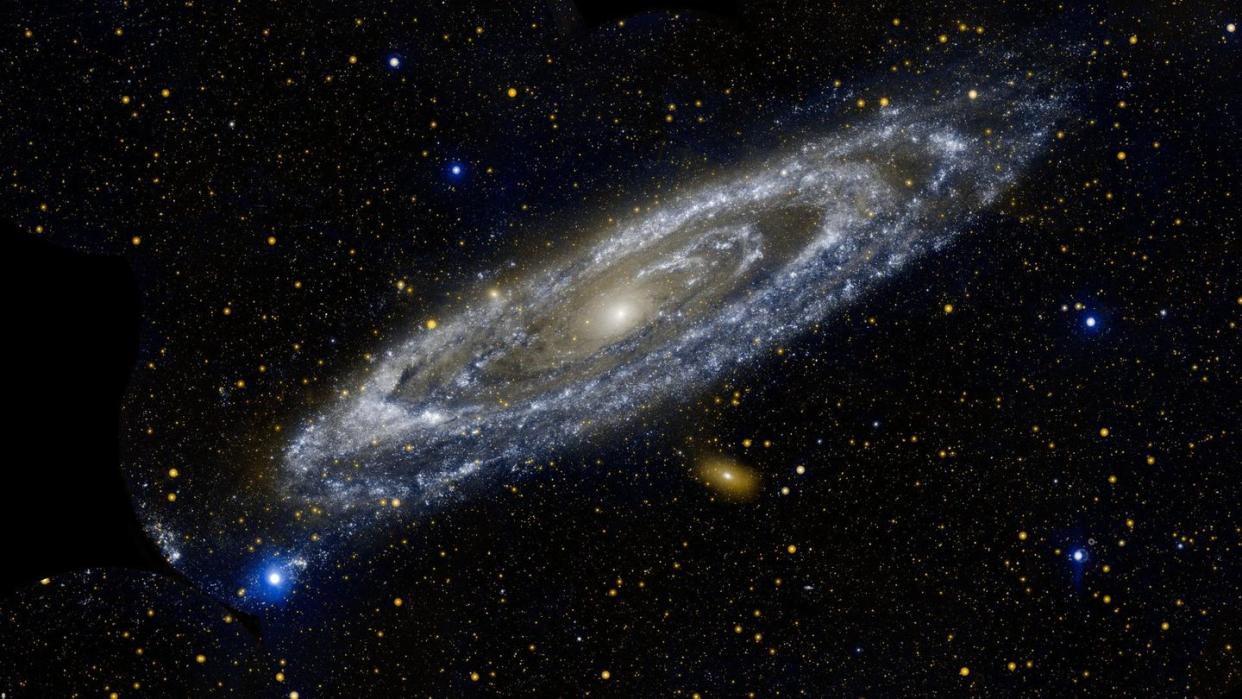Fugitive Stars Are Escaping From Their Galaxy—and Heading to Ours

Our Milky Way galaxy and Andromeda are destined to collide with each other in roughly 5 billion years, but the galaxies may already be exchanging stars.
A new study suggests that hypervelocity stars—those that travel in excess of 1,000 kilometers per second—could generate enough velocity to escape their home galaxy and travel to another.
These intergalactic travels are merely a stellar prelude to the massive smash-up in our galaxy’s future.
A lot is going to be happening in our neck of the universe in about 5 billion years.
For one, our star will officially enter its red giant phase—a climactic moment that has the unfortunate side effect of destroying Earth. But that won’t be the only big change. In about that same timeframe (give or take half a billion years), the Milky Way galaxy will also collide with Andromeda, which will form not a spiral, but a new elliptical galaxy some astronomers call “Milkdromeda.”
Don’t worry, we have a few billion years to workshop the name.
While this slow-motion galactic collision is still a long way off off, some scientists suggest that the Milky Way and Andromeda may already be exchanging stars. In a new paper, uploaded last week to the arXiv preprint server, Lukas Güzlow from the Karlsruhe Institute of Technology in Germany argues that certain stellar objects known as “hypervelocity stars,” or HVSs, maybe have already traveled the vast distances between our two galaxies.
“Hypervelocity stars are some of the fastest objects in the Galaxy,” the paper reads. “Some of them exceed escape velocity and are unbound to the Milky Way gravity. Based on recent Gaia observations, a number of them could have extragalactic origins.”
First predicted by stellar dynamicist Jack Gilbert Hills in 1988, HVSs are stars with velocities exceeding 1,000 kilometers per second, or roughly 621 miles per second. Our sun, for example, travels a measly (relatively speaking) 200 kilometers per second. Fast forward 17 years after Hills’ initial predictions, and the first HVS was discovered escaping the Milky Way. Since then, we’ve only found more. In 2021, for example, the National Astronomical Observatories of China announced the discovery of 591 high-velocity stars—43 of which moving into the hypervelocity realm capable of escaping the galaxy.
The trajectories of these stars suggest that they originate near the galactic center, were they are likely formed from interactions between binary stars and supermassive black holes. Another possible origin story is that one star in a binary star system goes supernova, which sends its orbital partner on a high-speed trek across the universe. While many of these stars’ trajectories indicate that they’ve punched a one-way ticket out of the Milky Way, the trajectories of some other HVSs suggest extragalactic origins.
To analyze this possibility, Güzlow used Gaia space observatory data to calculate the trajectories of 18 million HVSs under two different scenarios—one in which two galaxies were of equal mass, and another in which one galaxy was just half as massive as its counterpart. The starting positions of the HVSs were randomly generated near the center of Andromeda, and a small, non-zero percentage made their way to our galactic neighborhood—defined as roughly 50 kiloparsec radius from the Milky Way’s center.
While many of the stars retain their initial velocity, the journey between galaxies takes so long that some stars transition out of their main sequence (a.k.a. stars that fuse hydrogen like our Sun) state. Some of these stars will lose enough velocity to be captured by the Milky Way.
“To find out whether hypervelocity stars from Andromeda can reach the Milky Way, we have developed a simulation model of the gravitational system of the two galaxies,” the paper reads. “Only a small fraction of HVSs ejected from Andromeda are expected to migrate to the Milky Way. However, it might be possible to detect them based on their velocity and trajectory orientation.”
For now, Andromeda and the Milky Way are exchanging HVSs as a kind of friendly gift among galactic neighbors, but this stellar back-and-forth is only a prelude to the galaxy-altering smash-up some 5 billion years from now.
You Might Also Like


